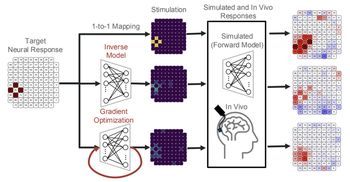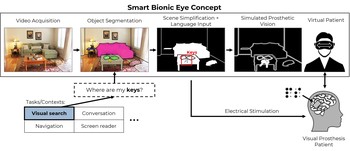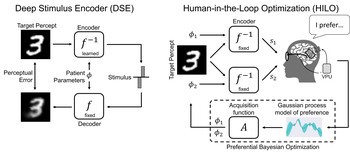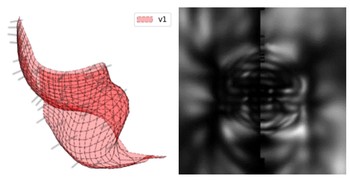Rather than pursuing a (degraded) imitation of natural sight, bionic vision might be better understood as a form of neuroadaptive XR: a perceptual interface that forgoes visual fidelity in favor of delivering sparse, personalized cues shaped (at its full potential) by user intent, behavioral context, and cognitive state.
Topic: Visual Prosthesis
Researchers Interested in This Topic
Ruyi Cao
Honors Student
Jacob Granley
Postdoctoral Researcher
Yuchen Hou
PhD Student
Lucas Nadolskis
PhD Student
Galen Pogoncheff
PhD Student
Lily M. Turkstra
PhD Student
Apurv Varshney
PhD Student
Research Projects
Bionic vision as neuroadaptive XR: Closed-loop perceptual interfaces for neurotechnology
Michael Beyeler 2025 IEEE International Symposium on Mixed and Augmented Reality Adjunct (ISMAR-Adjunct)
Deep learning-based control of electrically evoked activity in human visual cortex
We developed a data-driven neural control framework for a visual cortical prosthesis in a blind human, showing that deep learning can synthesize efficient, stable stimulation patterns that reliably evoke percepts and outperform conventional calibration methods.
Pehuén Moure, Jacob Granley, Fabrizio Grani, Leili Soo, Antonio Lozano, Rocio López-Peco, Adrián Villamarin-Ortiz, Cristina Soto-Sánchez, Shih-Chii Liu, Michael Beyeler, Eduardo Fernández bioRxiv
(Note: PM, JG, and FG are co-first authors. SL, MB, and EF are co-last authors.)
BionicVisionXR: An Open-Source Virtual Reality Toolbox for Bionic Vision
BionicVisionXR is an open-source virtual reality toolbox for simulated prosthetic vision that uses a psychophysically validated computational model to allow sighted participants to “see through the eyes” of a bionic eye recipient.
Towards a Smart Bionic Eye
Rather than aiming to one day restore natural vision, we might be better off thinking about how to create practical and useful artificial vision now.
End-to-End Optimization of Bionic Vision
Rather than predicting perceptual distortions, one needs to solve the inverse problem: What is the best stimulus to generate a desired visual percept?
Predicting Visual Outcomes for Visual Prostheses
What do visual prosthesis users see, and why? Clinical studies have shown that the vision provided by current devices differs substantially from normal sight.
pulse2percept: A Python-Based Simulation Framework for Bionic Vision
pulse2percept is an open-source Python simulation framework used to predict the perceptual experience of retinal prosthesis patients across a wide range of implant configurations.






